What do you put in a Dog Backpack

When it comes to outdoor escapades, your loyal canine companion can be an enthusiastic and willing participant. Whether you’re planning day hikes, a camping trip, or just a leisurely walk, you should know what to put in your dog backpack.
One way to fully engage your dog in the adventure is by utilizing a dog backpack. This handy accessory not only adds a touch of practicality but also enhances the overall experience for both you and your canine buddy.
As a rule of thumb, the weight your dog carries should not exceed 10-15% of their body weight.
What to Include in Your Dog’s Backpack
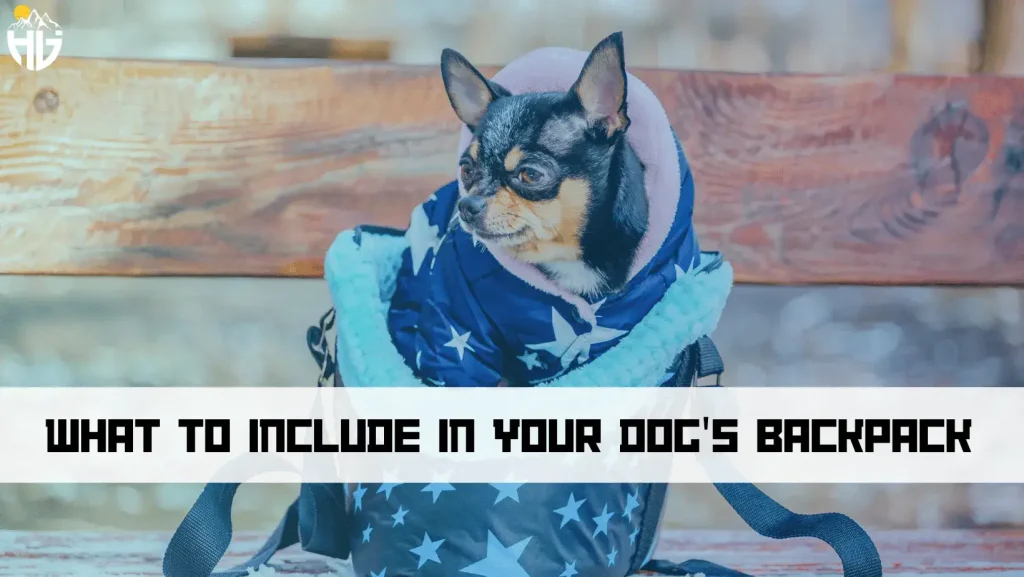
When preparing for an outdoor adventure with your furry friend, a well-packed dog backpack can make all the difference.
Not only does it allow your canine companion to contribute to the journey, but it also ensures they have the essentials they need for a safe and enjoyable experience.
Related Post
How to Take a Backpack on a Plane?
Hydration Essentials
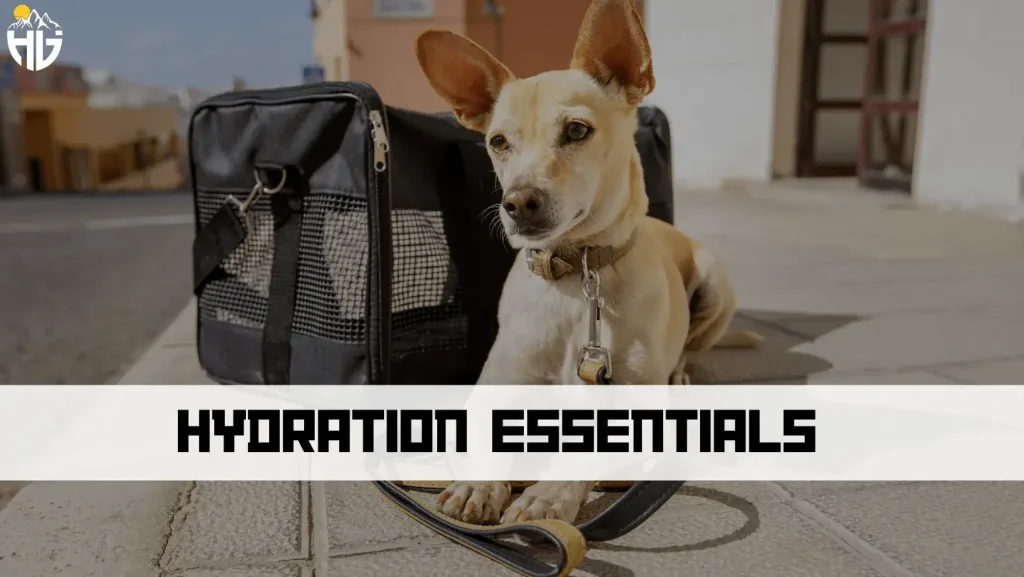
Make sure your dog’s backpack includes:
Water Bottles: Put a water bottle for you and your dog in its backpack. These should be lightweight and easy to drink from.
Collapsible Bowl: Pack a collapsible water bowl that takes up minimal space. This provides a convenient way for your dog to drink water without any hassle.
Nutritious Treats and Meals

To keep your puppy energized throughout the adventure put their favourite treats and meals in their backpack:
Trail Treats: Pack small, high-energy treats that can be used as rewards during the hike.
Meals: If your adventure spans mealtime, bring along portioned meals in a sealed container. Opt for easily digestible, nutrient-rich food.
Related Post
Why Do Cats Pant During Hiking?
Responsible Waste Management

As a responsible pet owner, it’s important to clean up after your dog even when you’re out in the wilderness:
Waste Bags: Include biodegradable waste bags to collect your dog’s waste and help keep the environment clean.
Hand Sanitizer: Keep a small bottle of hand sanitizer to ensure hygiene after handling waste bags.
Canine First Aid Kit

Accidents can happen, and being prepared with a canine-specific first aid kit is essential:
Bandages: Include adhesive bandages to cover minor cuts or scrapes.
Antiseptic Wipes: Pack antiseptic wipes to clean wounds and prevent infections.
Tweezers: Tweezers can be handy for removing splinters or thorns.
Gauze and Tape: These can be useful for larger wounds that require more comprehensive care.
Essential Identification and Leash

Ensure your dog is properly identified and that you can manage them effectively:
ID Tags: Make sure your dog wears an ID tag with up-to-date contact information.
Leash: Keep a sturdy leash on hand for areas that require your dog to be on a leash. This ensures they stay safe and under control.
Comfort Items
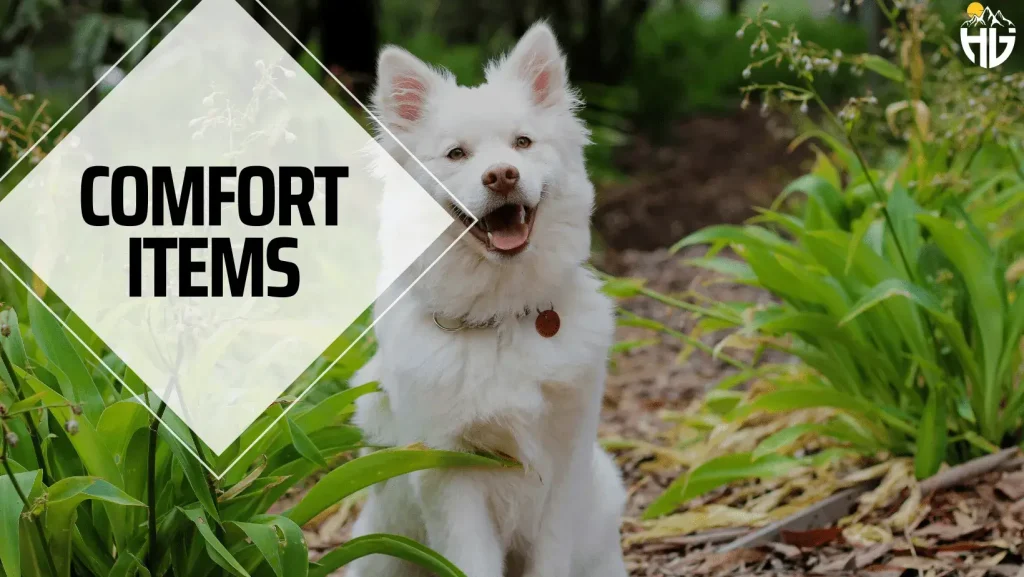
Don’t forget to include a few items that provide comfort and familiarity:
Small Blanket or Bed: If your dog is used to having a designated sleeping area, a small blanket or bed can help them feel at ease during breaks.
Favourite Toy: Pack a small toy that your dog loves. This can offer them a sense of familiarity and comfort.
Optional Gear

Depending on the nature of your adventure, you might consider additional items:
Rain Jacket: If you’re expecting wet weather, a lightweight rain jacket can keep your dog dry and comfortable.
Booties: In rough terrains or extreme temperatures, protective booties can shield your dog’s paws.
what do you put in a puppy pack?

Cooling Accessories for Dog Backpack
- A cooling vest can help regulate your dog’s body temperature during hot hikes. These vests are designed to retain water and provide evaporative cooling.
- Consider carrying a portable water dispenser with a built-in cooling feature. This ensures that your dog has access to cool water throughout the hike.
Dog-Friendly Bug Protection
- Just like humans, dogs can be bothered by insects. Choose an insect repellent specifically formulated for dogs to prevent bites and discomfort.
- In tick-prone areas, having a tick removal tool can be invaluable. Remove any ticks promptly to prevent potential health issues.
Rest and Shade
- Pack a lightweight, portable dog bed where your furry friend can rest comfortably during breaks.
- If your hike lacks natural shade, consider bringing a portable shade shelter or umbrella to protect your dog from the sun.
Canine Sunscreen
- Use a sunscreen formulated specifically for dogs in areas prone to sunburn, such as the nose, ears, and belly.
Doggie Backpack Organization
- Opt for a dog backpack with multiple compartments to keep items organised and easily accessible.
- Include items such as dog-safe wipes for cleaning paws and a small towel for drying.
how do you use a dog backpack?
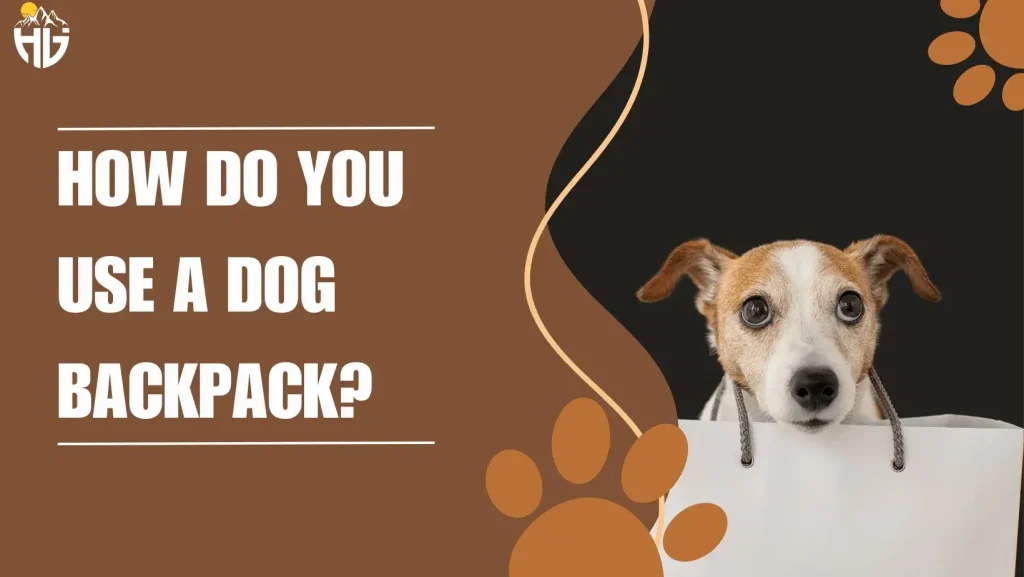
The weight limit you choose directly affects your dog’s well-being, comfort, and overall hiking experience.
Factors Influencing Weight Limit
Several factors play a role in determining how much weight your dog can safely carry:
Breed and Size: Smaller breeds generally have a lower weight-carrying capacity than larger breeds. A dog’s physical build also affects their ability to carry weight.
Fitness Level: Just like humans, a dog’s fitness level matters. Regular physical activity and exercise contribute to their strength and endurance.
Age: Puppies and senior dogs have different weight limits compared to adult dogs. Puppies are still developing, while senior dogs may have reduced mobility and strength.
Health Conditions: Dogs with existing health issues, especially those affecting their joints or back, may have lower weight limits. Consult your veterinarian before using a backpack.
Experience: Dogs that are used to wearing a backpack and carrying weight may have a higher weight tolerance than those new to the experience.
Signs of Overloading
Lagging Behind: If your dog is struggling to keep up or frequently lags behind, the extra weight might be too heavy.
Excessive Panting: If your dog is panting excessively or seems overheated, it could indicate that the load is too much for them.
Limping or Discomfort: Any signs of limping, stiffness, or discomfort are clear indications that the extra weight is causing strain.
Reluctance to Move: If your dog is hesitant to move or appears unwilling to walk, the backpack might be causing them distress.
Consult Your Veterinarian
Before introducing a backpack, especially for dogs with specific health conditions, consult your veterinarian. They can provide personalised guidance based on your dog’s individual needs, ensuring that the extra weight limit is safe and appropriate.
Reasons to Use a Dog Backpack for Your Hikes
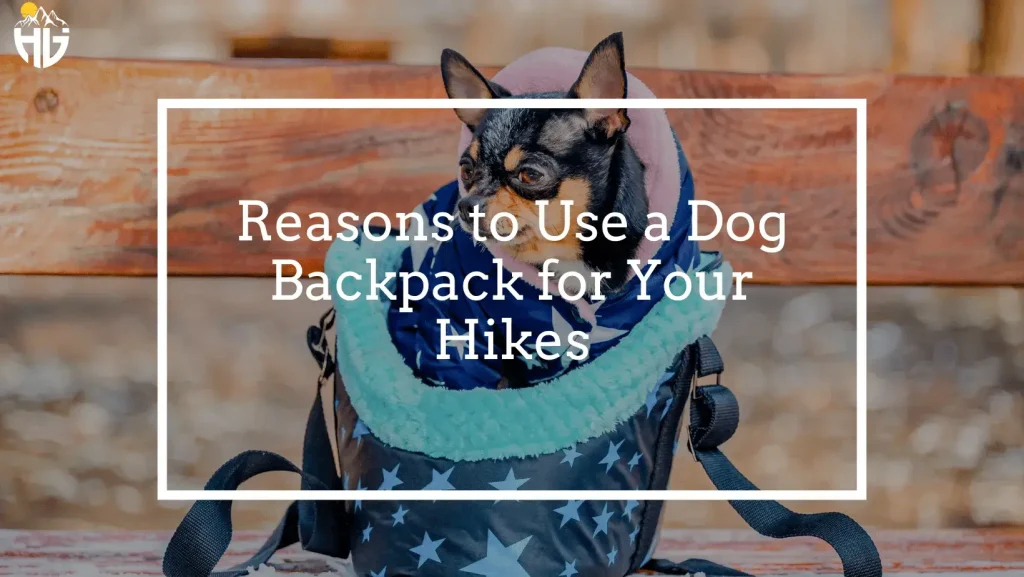
Shared Responsibility
By having your dog carry some of their essentials, you’re promoting a sense of shared responsibility, which can deepen your bond and create a stronger sense of companionship.
Physical Exercise
Carrying a backpack adds a level of physical exertion that can turn a leisurely hike into a more engaging workout. The added weight engages your dog’s muscles, contributing to their overall health and fitness.
Mental Stimulation
Dogs thrive on mental stimulation, and wearing a backpack introduces a new and intriguing element to their outdoor experience. The process of adjusting to the backpack, feeling its weight, and becoming familiar with the sensation can stimulate their minds and keep them mentally active.
Practical Weight Distribution
A well-designed dog backpack ensures that the weight is evenly distributed across your dog’s body. This prevents strain on specific body parts and minimises the risk of injury, allowing your dog to comfortably carry their load throughout the hike.
Engagement in the Journey
Dogs are natural explorers, and involving them in the journey by having them carry their own supplies keeps them engaged throughout the hike. They become active participants rather than passive observers, which can lead to a more fulfilling experience for both of you.
Energy Conservation
Allowing them to carry their own water, snacks, and essentials means that you’re conserving their energy and ensuring they have the necessary resources to stay hydrated and fueled.
How to Introduce and Use a Dog Backpack

The process involves helping your dog become comfortable with the new accessory, adjusting to the weight, and ultimately enjoying the experience of wearing and using the backpack during your outdoor adventures.
The Introduction Phase
It’s essential to introduce the backpack to your dog in a controlled and comfortable environment.
Choose a Calm Setting: Start indoors or in a familiar outdoor space where your dog feels safe and relaxed.
Present the Backpack: Place the backpack on the ground and allow your dog to investigate it at their own pace. Use positive reinforcement, praise, and treats to create positive associations.
Familiarisation: Let your dog sniff, paw, and interact with the backpack. Avoid any forceful or sudden actions that might startle them.
Empty Pack Exploration
Once your dog is familiar with the presence of the backpack, you can begin the process of getting them used to wearing it.
Open the Backpack: Gently open the backpack and place it on the ground. Allow your dog to approach and inspect it again.
Positive Associations: Use treats, praise, and encouragement to create positive associations with the backpack. Reward your dog whenever they show interest or curiosity.
Putting It On: With the backpack still empty, gently drape it over your dog’s back. Secure the straps loosely, ensuring your dog doesn’t feel restricted.
Short Periods: Initially, keep the backpack on your dog for short periods indoors. Monitor their behaviour and make sure they’re comfortable. If your dog seems agitated, remove the backpack and try again later.
Adding Weight Gradually
Once your dog is at ease with wearing the empty backpack, you can begin the process of gradually adding weight.
Start Light: Begin by placing a lightweight item, such as a small towel or blanket, in the backpack. This helps your dog become accustomed to the feeling of the added weight.
Monitoring Comfort: Pay close attention to your dog’s body language. If they appear uncomfortable or struggle to move, remove the backpack and adjust the weight or fit as needed.
Going on Adventures
Once your dog is comfortable wearing the backpack with added weight, it’s time to take them on their first outdoor adventure with it.
Choose an Easy Trail: Start with a short and easy trail for your first hike. This allows your dog to adjust to wearing the backpack in a new environment.
Monitor and Adjust: Pay attention to your dog’s behaviour and comfort level during the hike. If they seem fatigued or uncomfortable, remove the backpack and continue the hike without it.
Things to Consider When Choosing a Dog Backpack
The ideal backpack should not only fit comfortably but also meet both your and your dog’s needs.
With various options available, it’s important to consider several factors to ensure that you choose a backpack that enhances the experience for both of you.
Size and Fit
- Measure your dog’s chest girth and length to determine the appropriate size. Refer to the manufacturer’s sizing chart to find the best match.
- Look for a backpack with adjustable straps and multiple points of adjustment. This allows you to achieve a snug and secure fit.
Weight Distribution
- Opt for a backpack with compartments that allow for balanced weight distribution. This prevents strain on your dog’s body.
- Look for padded straps and back panels to provide additional comfort and reduce the pressure of the load.
Comfort and Freedom of Movement
- Choose a backpack that doesn’t restrict your dog’s movement, especially around the shoulders and legs.
- Check for padding on the chest and back areas to prevent chafing and discomfort.
Material and Durability
- Select a backpack made from durable and water-resistant materials that can withstand outdoor conditions.
- Ensure that zippers, buckles, and fasteners are of high quality to prevent breakage during hikes.
Ventilation
- Look for backpacks with breathable mesh panels that promote airflow and keep your dog cool.
Storage and Compartments
- Choose a backpack with multiple compartments for organised packing.
- Ensure that the backpack can accommodate the essentials without being too bulky or heavy for your dog.
Handle and Leash Attachments
- A sturdy handle on the backpack allows you to assist or control your dog when needed.
- Look for attachment points for leashes or harnesses to keep your dog secure during the hike.
Reflective Elements
- Select a backpack with reflective strips that make your dog more visible to others on the trail.
Ease of Cleaning
- Look for backpacks that are machine washable or easy to wipe down.
Conclusion
Incorporating a dog backpack into your outdoor activities can be a game-changer for both you and your pet.
Remember to start slow, pack thoughtfully, and prioritise your dog’s comfort and safety. With the right approach, your four-legged companion will become an enthusiastic and helpful trail partner.
FAQs
Can all dogs carry a doggy backpack?
Not all dogs are suitable candidates for carrying a doggy backpack. Factors like size, age, fitness level, and health conditions play a significant role in determining whether a dog can comfortably and safely carry a backpack.
What breeds are best suited for wearing a backpack?
Breeds with a sturdy build, good fitness level, and appropriate size for the backpack tend to be well-suited. Working breeds and those bred for activities like hiking often adapt better.
Can small dogs wear backpacks?
Yes, but the backpack and load must be proportionate to their size and strength. Lightweight packs designed for small breeds are available.
At what age can a puppy start using a backpack?
Puppies should wait until their bones and joints are fully developed, usually around 12 to 18 months, before carrying any weight.
Can senior dogs use backpacks?
Senior dogs can wear backpacks, but their load should be significantly lighter and chosen with consideration for their mobility and comfort.
Are there health conditions that prevent dogs from wearing backpacks?
Dogs with certain health issues like joint problems, back pain, or heart conditions might not be suitable for carrying a backpack. Consult a veterinarian before introducing one.
How do I determine the right weight for my dog’s backpack?
A general guideline is to keep the load between 10-15% of your dog’s body weight. However, this can vary based on factors like breed, fitness, and age.
Are there specific training steps for introducing a dog to a backpack?
Yes, introducing a backpack requires gradual adaptation. Start with an empty backpack and gradually add weight, allowing your dog to adjust over time.
Can a dog wear a backpack on long hikes?
With proper training and conditioning, many dogs can wear a backpack on longer hikes. Start with shorter hikes to gauge your dog’s comfort level.
What items should I never put in my dog’s backpack?
Avoid items that are too heavy, bulky, or sharp. Additionally, do not put anything in the backpack that might harm your dog or cause discomfort.
How can I tell if my dog is comfortable with the backpack?
Watch for signs of comfort, such as natural movement, wagging tail, and overall ease. If your dog shows signs of discomfort, consider adjusting the fit or removing the pack.

